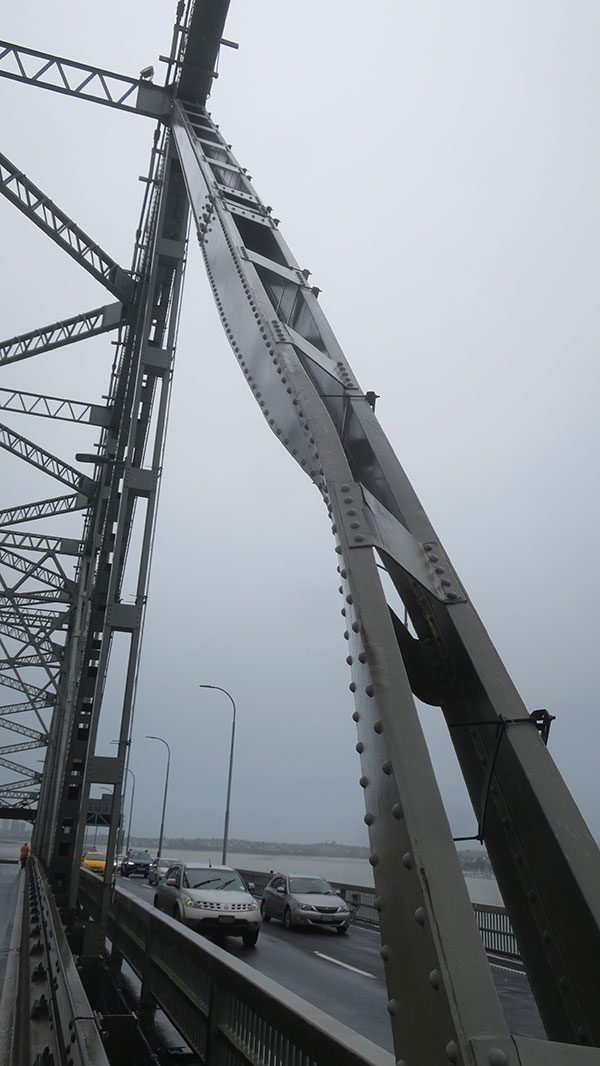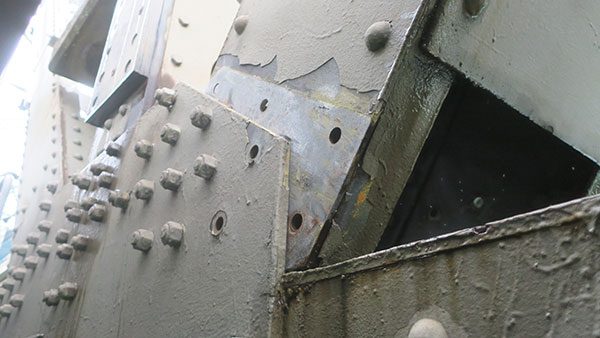Motorists urged to avoid damaged Auckland Harbour Bridge

The bridge strut bent out of shape after being hit by a truck on the Auckland Harbour Bridge.
The NZ Transport Agency is urging motorists and freight operators across Auckland to plan their weekday travel to avoid significant disruption caused by the closure of four lanes of the Auckland Harbour Bridge.
“While the Auckland Harbour Bridge is at half its usual capacity there are also significant knock-on effects across the transport network, with additional vehicles now switching to the Western Ring Route,” says NZTA senior journey manager Neil Walker.
“We ask people to consider working from home if possible or using public transport instead of taking the car. If you must travel, avoid peak times in the morning and evening and allow extra time for your journey. Heavy congestion and delays are expected on both sides of the bridge as well as other state highways and local roads.”
Congestion has been heavy over the weekend on the bridge, surrounding state highways and local roads following Friday‘s incident where two trucks were blown over by 127kph wind gusts, causing significant damage to the bridge superstructure.
“A temporary fix to reopen lanes may be possible in a few days but a permanent repair is weeks away. We‘re working on both and working as quickly as we can,” says Walker.
“We are really seeing the benefits of having a high quality alternative route to the Auckland Harbour Bridge via the Western Ring Route and SH16, SH18 and SH20, and are strongly encouraging those who do have to travel, especially heavy and freight vehicles, to use this route.
“The Northern Busway will be operating and buses are safe to use the clip-on lanes, however buses will be delayed as they join the queues to cross the bridge, so passengers should plan ahead and allow extra time for their journey.”

The bracket where the bridge truss has been sheared away, breaking the bolts holding it in place.
The NZTA is focused on doing everything possible to reopen the centre lanes of the Harbour Bridge as quickly as possible, however they will potentially remain closed for a number of weeks.
Repair work may not be visible on the bridge, but a team of nine structural engineers is working on the complex task of removing and replacing the strut that weighs about 4 tonnes and is 22.7 metres long. That includes modelling how to rebalance its load-bearing function so that it‘s safe to incrementally reopen lanes on the centre span with a temporary fix in place.
This work is ongoing and will take time. Fabrication of the replacement parts for the temporary and permanent fixes is also under way.
During the weekend bridge engineers completed safety inspections on the bridge. They‘ve been assessing how to repair or replace the damaged load-bearing upright strut hit by one of the trucks. The strut is important to the structure of the bridge as it helps support its weight. The engineers have also checked if other struts were damaged, given they‘ve had additional load transferred to them. The sheared end of the damaged strut has been temporarily bolted back on to the bridge.
While the damaged component of the structure is important, there is no risk to the structural integrity or overall safety of the Harbour Bridge. The north and southbound clip-on lanes are safe to use as they have their own supporting structure.
“We thank motorists for their ongoing patience with the inconvenience and disruption caused by the lanes closure. We‘re working to ensure the bridge can be back in operation as quickly as possible.
“We also thank the industry, freight and courier transportation sector for allowing extra time to take the alternative Western Ring Route. We have seen a significant drop in the number of trucks using the Harbour Bridge that contributes to this recovery. We‘re working to ensure the bridge can be back in operation as quickly as possible,” says Walker.
On average, more than 170,000 vehicles cross the Auckland Harbour Bridge on weekdays, with the configuration of the eight lanes changed four times a day to adjust to peak time traffic flows. With the four centre span lanes closed, there will be just two clip-on lanes in each direction.




